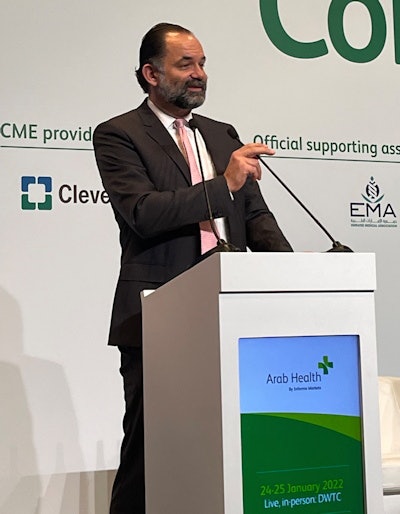
Minimally invasive cryoablation with the help of medical imaging can treat breast cancer without the need for general anesthesia, according to a talk given January 25 at Arab Health 2022 in Dubai.
 Prof. Dr. Michael Fuchsjäger. Image courtesy of Robert Stevens.
Prof. Dr. Michael Fuchsjäger. Image courtesy of Robert Stevens.In his presentation, Dr. Michael Fuchsjäger from the Medical University of Graz in Austria talked about the advantages of providing minimally invasive methods to kill tumor cells in women through tumor ablation, as opposed to conventional surgeries that could lead to scarring.
"If you correctly use minimally invasive therapy, you don't need general anesthesia," Fuchsjäger said. "All these procedures can be performed on an outpatient basis. The cosmetic outcome is definitely better if we use a one-millimeter needle instead of a surgical incision."
Tumor ablation has been explored in recent years as a minimally invasive way to treat solid cancers through chemical or thermal therapies, with more success seen in smaller tumors.
Imaging methods such as ultrasound, MRI, and CT have been used to guide and position needle probes. The probes are attached to a generator, and once a probe is inserted into the tumor, it burns or freezes the tumor at above 50°C or below -40°C to kill cancer cells.
For breast cancer, patients are in the supine position. While most minimally invasive therapies don't require anesthesia, conscious sedation could be used to relax patients and ease pain.
Thermoablation, where extreme heat is used, requires electrodes with needle sizes ranging from 1.6 mm to 2 mm. Radiofrequency, microwave, or focused ultrasound can be used to help position the electrodes.
Fuchsjäger said ultrasound can be considered noninvasive in this scenario, even though the process is "tricky" and takes "a lot of time." Some patients also may need some anesthesia due to the high temperatures. Too high of temperatures could also lead to boiling of liquids in the immediate area of therapeutic interest.
With cryoablation, thinner needles are used, between 1.2 mm and 2 mm. Argon gas or liquid nitrogen are used, and imaging modalities are used to guide needle electrode placement. The surrounding skin is meanwhile continuously warmed, and several freeze-thaw cycles are employed.
Previous research Fuchsjäger cited in his presentation supports the use of cryoablation.
A 2004 study published in Radiology found that cryoablation achieved complete necrosis for tumors in seven out of nine invasive ductal carcinoma cases. The tumors were less than or equal to 1.8 cm wide. The researchers used two freeze-thaw cycles ranging from 32 to 40 minutes each.
Another study published in 2011 in European Radiology found that 14 out of 15 tumor cases achieved complete necrosis. One needle electrode was used, and two freeze-thaw cycles were used here as well.
"These first studies actually show that minimally invasive therapy with freezing is feasible. It was successful in the treatment of early-stage breast cancer," Fuchsjäger said. "Our friends from surgery say it's easy to excise small cancers with local anesthesia. This is the approach of the future."
He added that patients also experienced no pain throughout the operation.
But some requirements must be met to consider either method. Tumors must be less than or equal to 2 cm wide and be visible on ultrasound, MRI, or CT. The distance from the tumor to the skin must also be greater than or equal to 1 cm to avoid damage outside of tumor cells.
Fuchsjäger's time focusing on Arab health has been recognized over the years. Between 2009 and 2012, he helped rebuild and expand a small and aging radiology unit in the United Arab Emirates to include digital imaging.
The unit's efforts were recognized in 2010 with accreditation from the Joint Commission International (JCI), as well as an Excellence in Digital Imaging and Diagnostics award received in 2012 from the Arab Health Congress.
For cryoablation to be more widely accepted, Fuchsjäger said there must be paradigm shifts in how to look at breast cancer treatment options and their outcomes. He also said there is not much evidence, including multicenter findings, on cryoablation's success against larger and multicentric tumors, as well as against invasive lobular breast cancer and ductal carcinoma in situ.
He pointed to how he worked on just one minimally invasive operation in 2021.
"I would love to do 100, because it's an easy procedure for an experienced radiologist with ultrasound guidance," he said. "All [other] patients we were told could be included for minimal invasive therapy could be surgically treated with local anesthesia."




.fFmgij6Hin.png?auto=compress%2Cformat&fit=crop&h=100&q=70&w=100)




.fFmgij6Hin.png?auto=compress%2Cformat&fit=crop&h=167&q=70&w=250)











